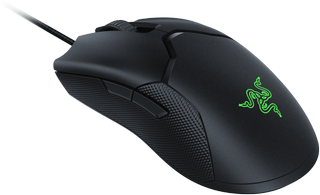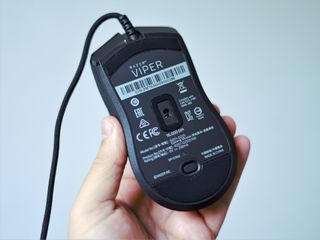Razer has lots of different gaming mice, and each one is excellent in its own right. The Viper isn't like any of those, and for the competitive gamers out there, it's about to become your new best friend.
Razer involved professional gamers in the development of the Viper from the start. Their "for gamers, by gamers" mantra has never been stronger.
But it's not just about making a mouse the pros like. Razer has put thoughtful design choices into the Viper along with cutting edge technology. And on a personal level, it might finally be the mouse to make me retire my much-loved Deathadder Elite.

Bottom line: If you care about your gaming, the Viper is the mouse for you.
For
- Lightweight
- Accurate and responsive optical sensor
- Ambidextrous
- DPI switch on base, no accidental clicks
- New drag-free cable
Against
- No detachable USB cable
Razer Viper tech specs
- Razer Optical Mouse Switches for ultra-fast response
- 5G Optical Sensor, 16,000 DPI
- Up to 450 Inches Per Second (IPS) / 50 G acceleration
- 69g weight
- Razer Speedflex Cable for minimal drag and smooth control
- Onboard DPI storage
- Eight Programmable Buttons
Designed by pros, enjoyable for everyone

Razer hasn't taken the design of the Viper lightly, spending a large amount of time working alongside pro gamers to get it just right. Through their rigorous testing, in some cases during big tournaments, and the follow up feedback, Razer finally settled on the finished product it's launching to the world.
The input of the professionals shouldn't be taken lightly, either. The cynical out there would assume it's merely a marketing exercise designed to look good in ads, but that's simply not the case. Every aspect of the Viper's design has been worked on in conjunction with the very people that Razer is targeting with this mouse.
Except you don't have to be a pro to enjoy it. And that's what makes it so special. It's an incredible gaming mouse that anyone can use and enjoy.
A brilliant gaming mouse for right and left-handed players.
One of the key design features is that the Viper is ambidextrous, in itself still a rarity in gaming mice. The symmetrical design has two customizable buttons on each side, so whether you're right or left-handed you have the exact same flexibility. As with any other Razer mouse, you can assign these to custom functions within Synapse 3, and with Hypershift you can add more than just four. However, I have found that the buttons on the opposite side to my thumb are actually useable on the Viper, which isn't always the case.

That's partly down to its shape. About the only bad thing I could really say about the Viper is that because it's ambidextrous the ergonomics take a slight hit. A Deathadder this is not, but being available to both right and left-handed gamers is more important. The Viper has a fairly low-profile body, but still has just enough curve that it fits perfectly into your palm. It doesn't feel too narrow, and for my hands at least, the length is perfect.
What's also impossible to ignore is the weight. Razer has kept the weight down to an incredibly low 69 grams, without the need to drill holes in the body to shed some of the heft. On the outside, it looks and feels like the sort of plastic you'd find on any other Razer mouse, but the construction is different so as to provide a blend of rigidity, durability and lightness.
The Viper just feels right.
In the past, I've never been too fond of light mice, but there's something about the Viper which changes that. Whether it's dumb luck, the feedback from the pros or some careful science by incredibly smart engineers, it just feels right. Moving the mouse is effortless, it simply glides across the mouse pad with the deftest of flicks. FPS gamers in particular who play with low DPI settings will love it, moving long distances with almost no effort.
And speaking of DPI, one of my favorite features is that Razer moved the switch to change this on the fly to the bottom of the mouse, making it impossible to accidentally trigger.
Optical switches now in gaming mice

One of the headline features of the Viper is the new switches. For the first time, Razer has brought its optical switch technology, currently known from the Huntsman keyboard, to its mice. And the idea is entirely the same.
Mechanical switches, however good, involve some kind of delay and have reduced durability over the optical alternatives. With the purple switches found now on the Viper, albeit in a slightly different design, there is no delay as there is no contact required between pieces of metal. There's also no rebound, just instant actuation. As the light beam is broken, the click is registered.
Are Razer purple opto-mechanical switches worth the price?
What's remarkable is that to use it feels no different to Razer's other, traditional mice switches. The Huntsman keyboard has a noticeably different feel to, say, the green mechanical switches on the BlackWidow, but in the Viper you wouldn't know they were different without actually being told.
It's hard to judge just how fast and accurate these switches are, because the brain doesn't work that fast. But whether gaming or just using the PC in every day use, the Viper feels sharp, accurate and fast.
The feel of the switches is familiar, but underneath the performance and durability is much better.
That extends to the 16,000 DPI optical sensor on the underside, too. Such a quality sensor is nothing alien to users of other Razer mice like the DeathAdder Elite, and it's every bit as precise as ever. However, coupled with the lightness of the mouse, I've found that I've actually switched to a lower DPI, as the Viper just feels so nimble in the hand. Sadly, it can't cure my potato aim, but the control you feel you have is sublime. There's also no fatigue that I've felt during my time with the Viper so far, which itself is a rarity.
Features that gamers will go crazy for

One of my favorite features is that Razer moved the switch to change the DPI on the fly to the bottom of the mouse. Why? Because you can't accidentally click it down there during the heat of battle. We've all done it. It drives me crazy when it happens just browsing the web, let alone during a game.
As there's only one button now, there's a simple colored LED that shows you which DPI setting you're currently on. Each sensitivity stage you apply in Razer Synapse 3 will have a corresponding color above it so you can identify easily on the mouse.
What's also good to see is that the Viper comes with onboard storage. This in particular is something built for the pros, since they regularly move between PCs and want to take their custom settings with them. Without onboard storage, that involves installing and logging in to Razer Synapse, but with the Viper you simply set it up and it'll take it with you from machine to machine.
The Viper has easily the best cable on a gaming mouse.
And perhaps the final thing to point out is the cable. I'd have liked to see a detachable one in all honesty, especially given the apparent target audience of the Viper. But what a cable it is. I can already hear the comments, "how can you get excited about the cable?" Razer's new Speedflex cable is amazing and essentially eliminates the need to use a mouse bungee to remove cable drag.
It's Razer's own braided cable design, but it's incredibly light, very long and actually works. It will still fit into a bungee if you wish, but you don't really need it. I've been using a bungee with the DeathAdder because without it the cable drags against both my mousepad and my desk, but with the Viper all that has gone away. It's amazing how something so simple can make such a difference to how it feels to use a mouse.
Should you buy the Razer Viper? Absolutely

I've never been shy of my love for the Razer DeathAdder Elite and how I couldn't see myself using another mouse. That is, until the Viper came along. It's as close as it comes to a perfect gaming mouse. And it's not bad to use for day-to-day computing, either.
The Razer Viper is the gaming mouse to buy.
There's a lot that's gone into the design and construction of the Viper, from the pro-gamer involvement to the optical switches, the construction of a light body without drilling holes in it to the drag-free cable. Each and every part of the Viper has been carefully considered to be the best that it can be.
And the best is right. This is the best mouse Razer currently makes, and it's standing tall above everything else out there right now. It sets a high bar for everyone else, even the rest of the Razer range, to reach, and it hasn't wasted time on flashy gimmicks or pointless features.
The Viper is simply an exceptional mouse with an attractive price tag at just $80. That's also worthy of recognition, but whatever it cost, the end result is the same. The Razer Viper is the gaming mouse to buy right now.

The new king for competitive gamers
The Viper is magnificent, almost impossible to fault and packed with thoughtful design elements and amazing performance that makes it impossible not to recommend to any PC gamer.

Richard Devine is a Managing Editor at Windows Central with over a decade of experience. A former Project Manager and long-term tech addict, he joined Mobile Nations in 2011 and has been found on Android Central and iMore as well as Windows Central. Currently, you'll find him steering the site's coverage of all manner of PC hardware and reviews. Find him on Mastodon at mstdn.social/@richdevine
